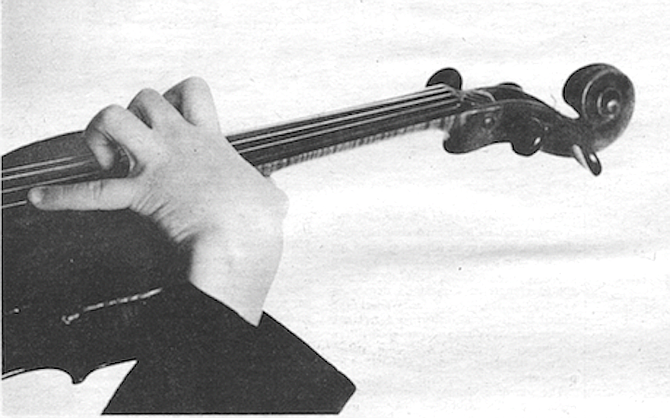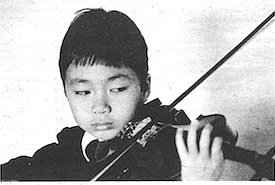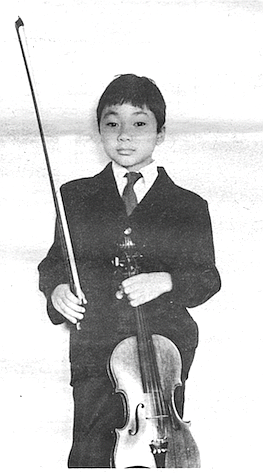 Facebook
Facebook
 X
X
 Instagram
Instagram
 TikTok
TikTok
 Youtube
Youtube

In the fourth grade I took up the cello. I took it up with both hands, straining muscles, and eventual disappointment.
When we were signing up for instruments, I thought I was being clever. We could choose the violin or the cello, and all my classmates (except for one girl who, years later, would stick in my mind as cello-shaped herself) decided to study the violin. A lightning calculation assured me that my chances for making the high school orchestra would be greater if I studied an instrument in which few others took an interest. Hence the cello.

As it turned out, I never made the high school orchestra because I never made it through the year with the cello. My excuse at the time was not that I lacked talent, but that a fourth grader could get a hernia lugging around an oversized machine gun case. I concluded that I, too, should have turned to the violin because the violin is small enough to be handled by anyone with ease, if not with proficiency. There is no need to stretch, wheeze, or grimace in order to play the thing.
And even about that I have almost changed my mind, and happily so. Although Binh Zanh Luu does not wheeze or grimace when his violin rests on his extended arm, he does have to do a little stretching, even though the instrument he plays is three-quarter size. The reason is plain. Binh’s nose comes up to a tall man’s belt buckle, and this nine-year-old tips the scales at a mere forty-five pounds when he is in shape (closer to fifty when he lets himself attack the cookie jar with abandon).
But no matter. His featherweight status does not seem to have hindered his musical progress. He has taken violin lessons for only two years, and already he is being talked about as the Vietnamese Heifetz. That appellation is surely premature — the boy needs another five or ten years to illustrate his true timbre — but it is not farfetched. This child has talent, and Eugene Ormandy’s scout should keep Binh’s name in the back of his mind.
Binh recently gave a private recital, his sixteenth, at the home of his instructor, William Benner, who says a student like Binh comes into a music teacher’s career once in a lifetime, if at all, and that most teachers never have the opportunity to work with such native talent. Benner and his wife befriended the large Luu family when they arrived here as refugees after taking the last plane out of Saigon; they have now settled in Lemon Grove. After some discussion it was decided that Binh would be the child on whom Benner would bestow his decades of musical learning. These two years have not been a disappointment to him, remarks Benner, who is as protective and proud of Binh as a society matron might be of her prize begonias.
The recital was given in the Benners’ Mt. Helix studio, which is decorated with an eclectic assortment of oriental art, mainly Chinese, but with a few lonely Japanese and Southeast Asian items thrown in. Considering the violinist, the setting seemed well chosen. My wife and I arrived a few moments late and got the last seats, hard against one wall and right behind a woman whose hair kept getting in the way. Much of the time we could see nothing of Binh (I hadn’t been in a chair so low since junior high school), and I finally let etiquette go and got up on my haunches. Even then I could see only his head and his instrument. Behind Binh, at the piano, was accompanist Gabriel Arregui' an accomplished performer at only sixteen and a young man for whom I felt sorry because he was overshadowed by the little whip in front of him.

Binh’s first selection was Paganini’s Concerto in D. “This is his worst piece," whispered Gene LeFave, who teaches Binh at the private Holy Innocents School on Winona Avenue. And LeFave was right. Binh had some trouble with the higher ranges — he tends to squeak — and some portions calling for particular vibrancy were too muted. Worse, his timing was minutely off, not so much as to be distinct to the ear, but just enough to leave a question in the mind. His trouble, I thought at the time, was in his tiny forearms and thin fingers. He just didn’t have the strength to order those strings around as he should; a couple years and fifteen pounds will make the difference.
Throughout this opener Binh was a study in concentration, almost to the point of being stilted. His eyes remained firmly fixed on some unseen spot on the righthand wall, as though trying to draw from the plaster the next few bars.
LeFave later noted that Binh works with a single-mindedness unusual in one so young and that his excellence in school parallels his achievements in his musical avocation.
I confess I was a little disappointed as Binh walked into the side room to take a breather. Perfection is not to be anticipated in such situations, yet I had come expecting to hear a copy of an Angel recording. But my mood changed and my expression lightened when Binh returned for his second set, which included Fritz Kreisler’s “Liebesfreud,” Kreisler’s arrangement of C. W. von Gluck’s “Melody,” and Pablo de Sarasate’s “Jota Aragonesa,” a Spanish dance. Binh redeemed himself by being quite good on the second and third and verging on the superb on the first. The thirty others in the room cocked their ears as “Liebesfreud” began — it had all the proper zest and spunk and made up for the earlier squeaks.
After another break Binh returned for Bazzini’s “Round (or Dance) of the Goblins,” which may best be compared to “The Flight of the Bumblebee.” The sheet music, which I later found in an anteroom, was subtitled: “a concert solo for players who have mastered every technical difficulty,” and that is what is known as an understatement. “No one plays it,” explained Benner. “It’s simply too hard.” But apparently not for Binh; it was his best piece of the evening.
This Vietnamese prodigy is convinced that his future lies at the end of his rosined bow, and he is probably right. Benner, LeFave, and other backers want him to have a public recital as soon as possible. They plan to rent a hall at University of San Diego for an as yet undetermined date, perhaps in May. In the meantime, Binh rehearses. He knows that he must come reasonably close to the audience’s exaggerated expectations if he is to make a mark, for himself, and he is fine-tuning his repertoire to do just that. Some of his “regular” selections will go; new ones will take their place. Benner is looking for that happy combination of particular difficulty in the pieces and particular proficiency in Binh’s playing of them. He is confident that his star pupil will be prepared for his public.
For my part, I just hope Binh some day realizes how lucky he was not to be sidetracked into that dead end of an instrument, the cello. He could have ended up like Pablo Casals or, worse, like me. □


In the fourth grade I took up the cello. I took it up with both hands, straining muscles, and eventual disappointment.
When we were signing up for instruments, I thought I was being clever. We could choose the violin or the cello, and all my classmates (except for one girl who, years later, would stick in my mind as cello-shaped herself) decided to study the violin. A lightning calculation assured me that my chances for making the high school orchestra would be greater if I studied an instrument in which few others took an interest. Hence the cello.

As it turned out, I never made the high school orchestra because I never made it through the year with the cello. My excuse at the time was not that I lacked talent, but that a fourth grader could get a hernia lugging around an oversized machine gun case. I concluded that I, too, should have turned to the violin because the violin is small enough to be handled by anyone with ease, if not with proficiency. There is no need to stretch, wheeze, or grimace in order to play the thing.
And even about that I have almost changed my mind, and happily so. Although Binh Zanh Luu does not wheeze or grimace when his violin rests on his extended arm, he does have to do a little stretching, even though the instrument he plays is three-quarter size. The reason is plain. Binh’s nose comes up to a tall man’s belt buckle, and this nine-year-old tips the scales at a mere forty-five pounds when he is in shape (closer to fifty when he lets himself attack the cookie jar with abandon).
But no matter. His featherweight status does not seem to have hindered his musical progress. He has taken violin lessons for only two years, and already he is being talked about as the Vietnamese Heifetz. That appellation is surely premature — the boy needs another five or ten years to illustrate his true timbre — but it is not farfetched. This child has talent, and Eugene Ormandy’s scout should keep Binh’s name in the back of his mind.
Binh recently gave a private recital, his sixteenth, at the home of his instructor, William Benner, who says a student like Binh comes into a music teacher’s career once in a lifetime, if at all, and that most teachers never have the opportunity to work with such native talent. Benner and his wife befriended the large Luu family when they arrived here as refugees after taking the last plane out of Saigon; they have now settled in Lemon Grove. After some discussion it was decided that Binh would be the child on whom Benner would bestow his decades of musical learning. These two years have not been a disappointment to him, remarks Benner, who is as protective and proud of Binh as a society matron might be of her prize begonias.
The recital was given in the Benners’ Mt. Helix studio, which is decorated with an eclectic assortment of oriental art, mainly Chinese, but with a few lonely Japanese and Southeast Asian items thrown in. Considering the violinist, the setting seemed well chosen. My wife and I arrived a few moments late and got the last seats, hard against one wall and right behind a woman whose hair kept getting in the way. Much of the time we could see nothing of Binh (I hadn’t been in a chair so low since junior high school), and I finally let etiquette go and got up on my haunches. Even then I could see only his head and his instrument. Behind Binh, at the piano, was accompanist Gabriel Arregui' an accomplished performer at only sixteen and a young man for whom I felt sorry because he was overshadowed by the little whip in front of him.

Binh’s first selection was Paganini’s Concerto in D. “This is his worst piece," whispered Gene LeFave, who teaches Binh at the private Holy Innocents School on Winona Avenue. And LeFave was right. Binh had some trouble with the higher ranges — he tends to squeak — and some portions calling for particular vibrancy were too muted. Worse, his timing was minutely off, not so much as to be distinct to the ear, but just enough to leave a question in the mind. His trouble, I thought at the time, was in his tiny forearms and thin fingers. He just didn’t have the strength to order those strings around as he should; a couple years and fifteen pounds will make the difference.
Throughout this opener Binh was a study in concentration, almost to the point of being stilted. His eyes remained firmly fixed on some unseen spot on the righthand wall, as though trying to draw from the plaster the next few bars.
LeFave later noted that Binh works with a single-mindedness unusual in one so young and that his excellence in school parallels his achievements in his musical avocation.
I confess I was a little disappointed as Binh walked into the side room to take a breather. Perfection is not to be anticipated in such situations, yet I had come expecting to hear a copy of an Angel recording. But my mood changed and my expression lightened when Binh returned for his second set, which included Fritz Kreisler’s “Liebesfreud,” Kreisler’s arrangement of C. W. von Gluck’s “Melody,” and Pablo de Sarasate’s “Jota Aragonesa,” a Spanish dance. Binh redeemed himself by being quite good on the second and third and verging on the superb on the first. The thirty others in the room cocked their ears as “Liebesfreud” began — it had all the proper zest and spunk and made up for the earlier squeaks.
After another break Binh returned for Bazzini’s “Round (or Dance) of the Goblins,” which may best be compared to “The Flight of the Bumblebee.” The sheet music, which I later found in an anteroom, was subtitled: “a concert solo for players who have mastered every technical difficulty,” and that is what is known as an understatement. “No one plays it,” explained Benner. “It’s simply too hard.” But apparently not for Binh; it was his best piece of the evening.
This Vietnamese prodigy is convinced that his future lies at the end of his rosined bow, and he is probably right. Benner, LeFave, and other backers want him to have a public recital as soon as possible. They plan to rent a hall at University of San Diego for an as yet undetermined date, perhaps in May. In the meantime, Binh rehearses. He knows that he must come reasonably close to the audience’s exaggerated expectations if he is to make a mark, for himself, and he is fine-tuning his repertoire to do just that. Some of his “regular” selections will go; new ones will take their place. Benner is looking for that happy combination of particular difficulty in the pieces and particular proficiency in Binh’s playing of them. He is confident that his star pupil will be prepared for his public.
For my part, I just hope Binh some day realizes how lucky he was not to be sidetracked into that dead end of an instrument, the cello. He could have ended up like Pablo Casals or, worse, like me. □
Comments